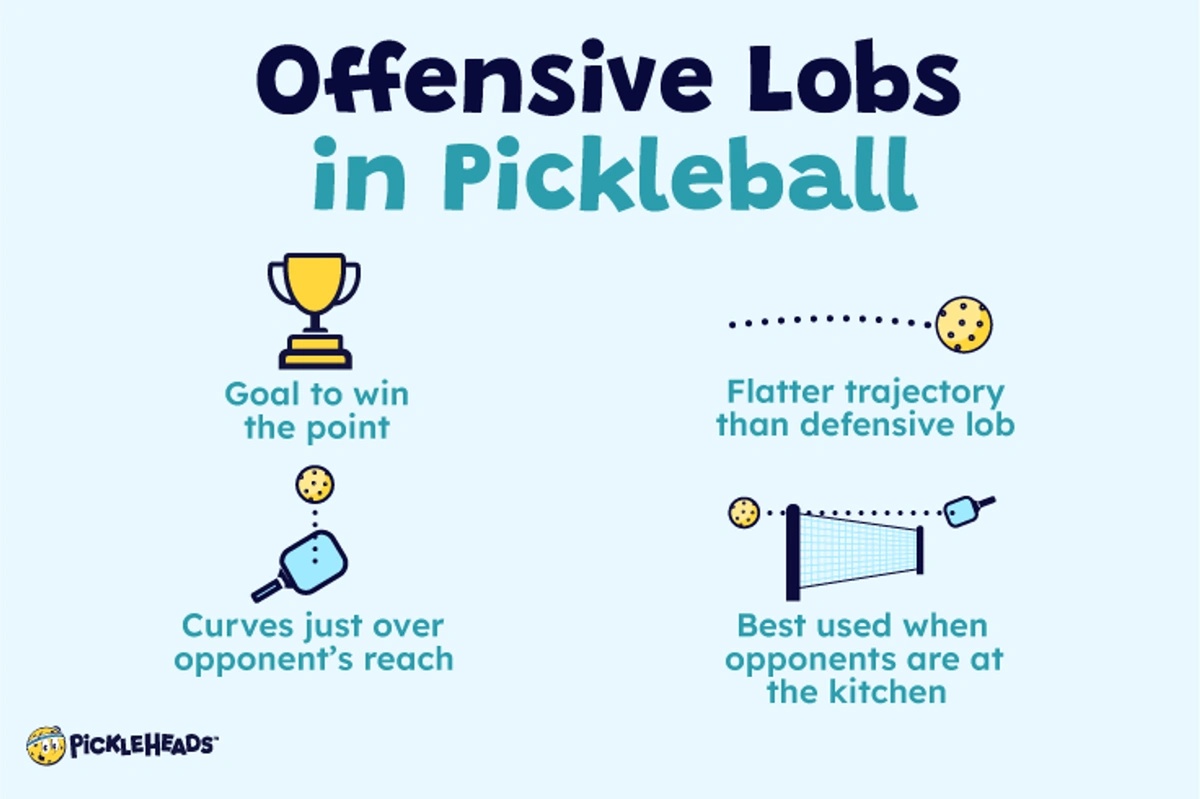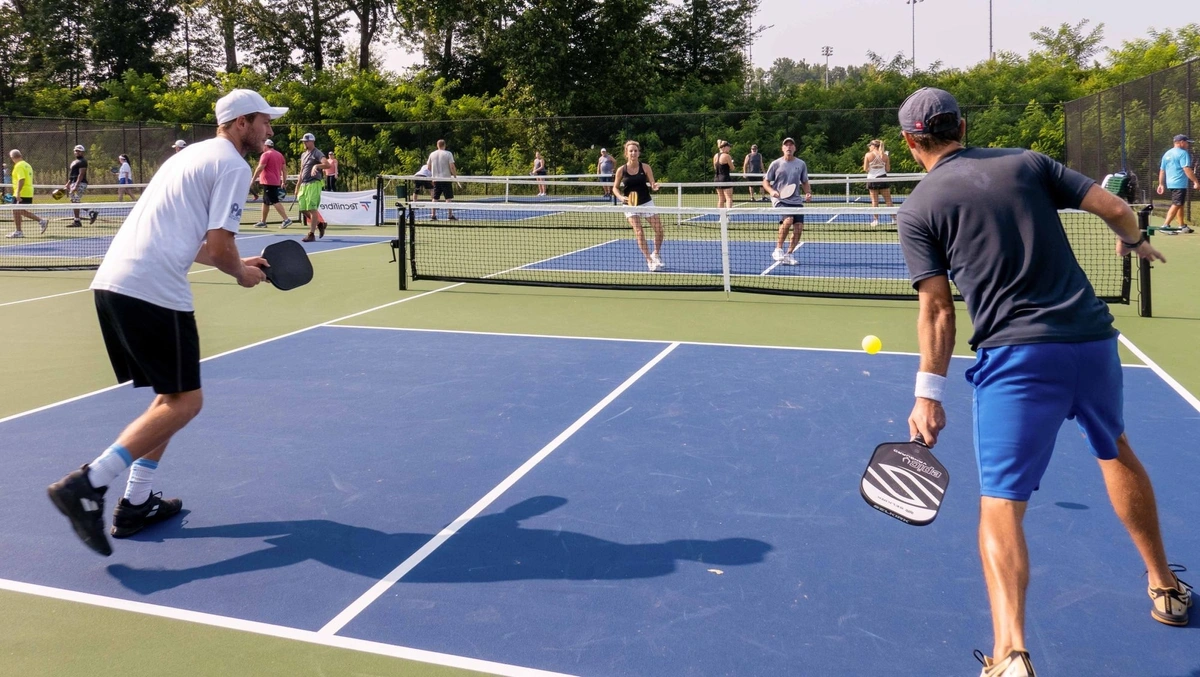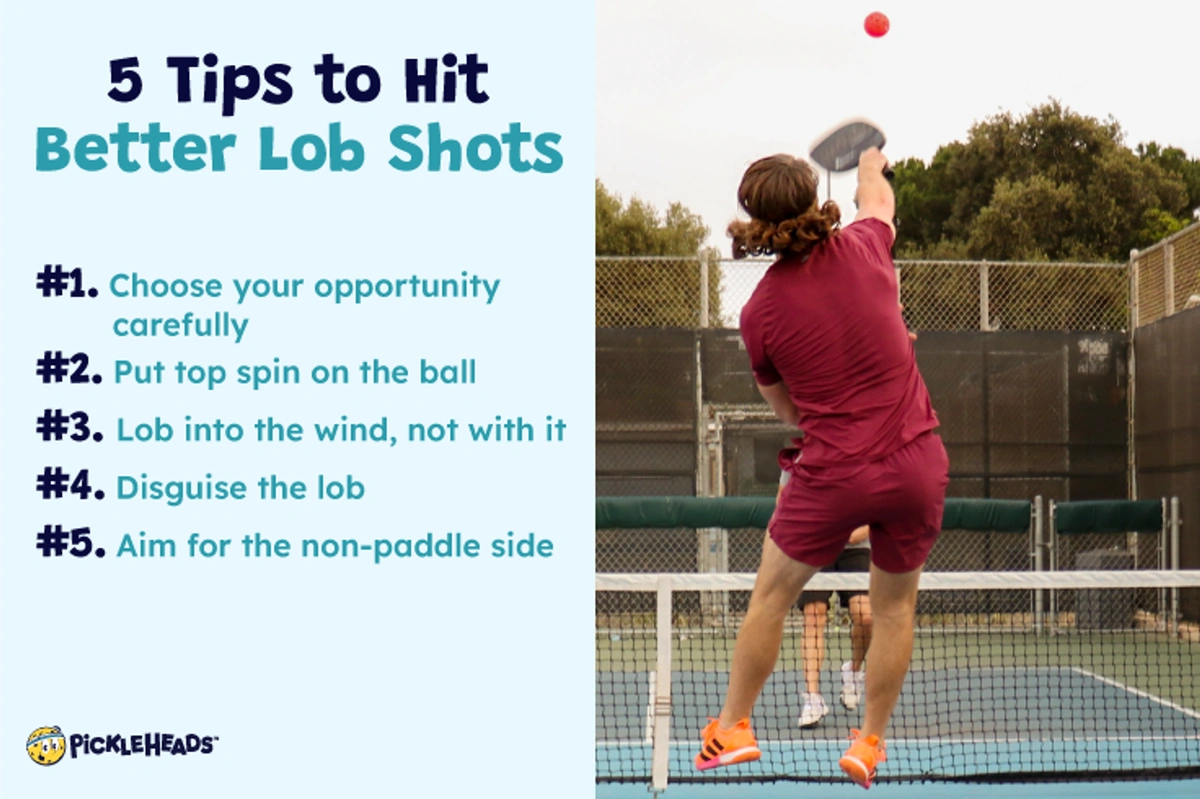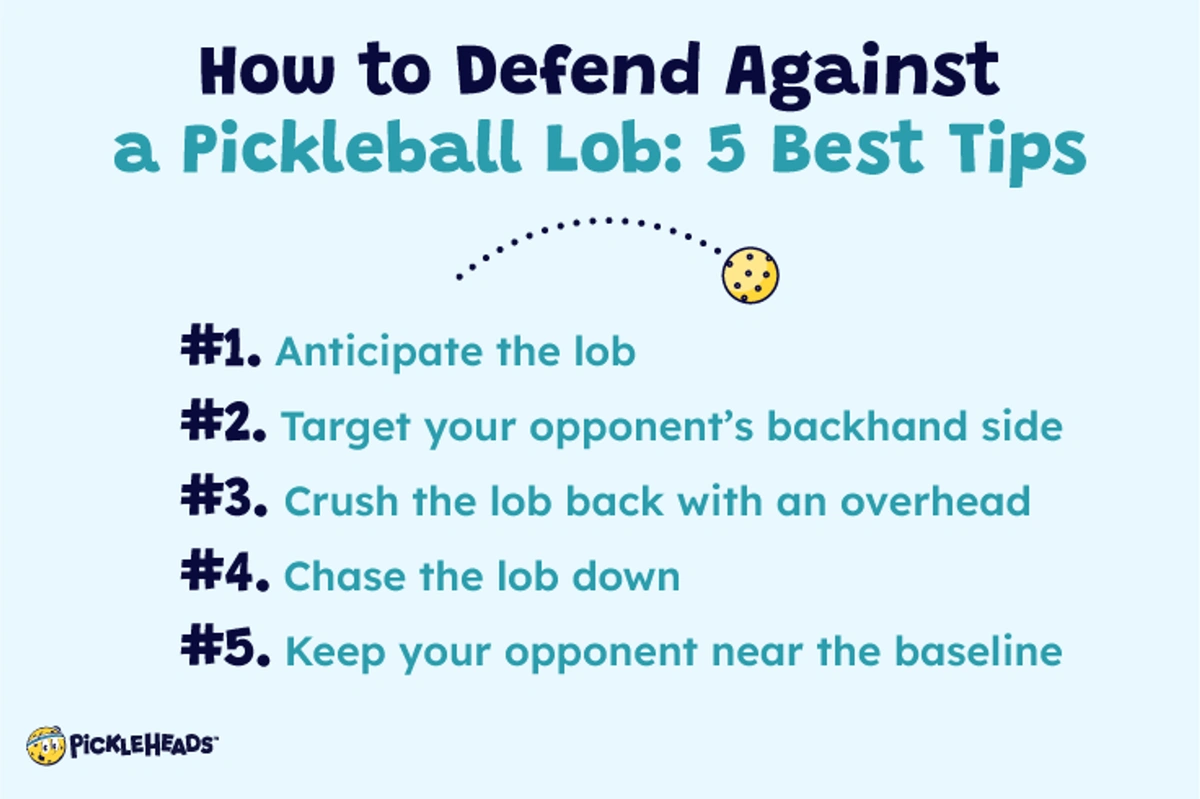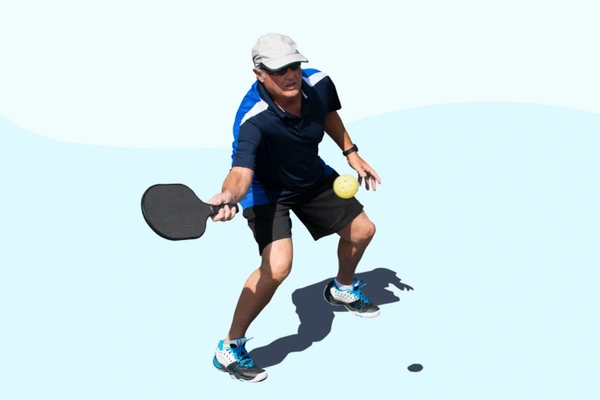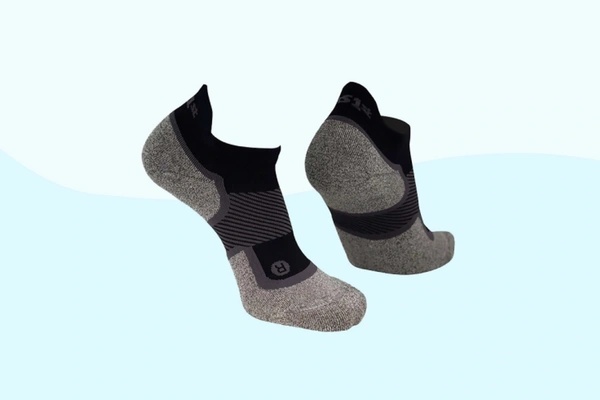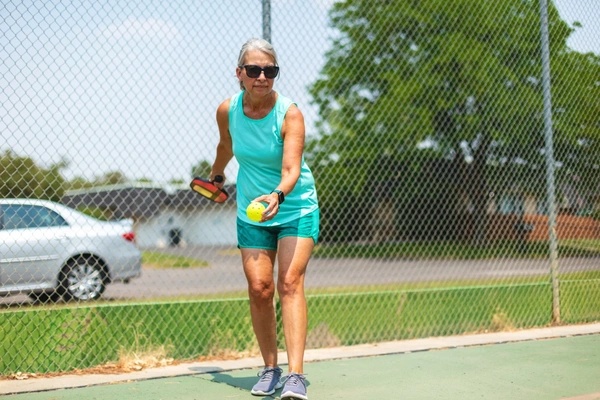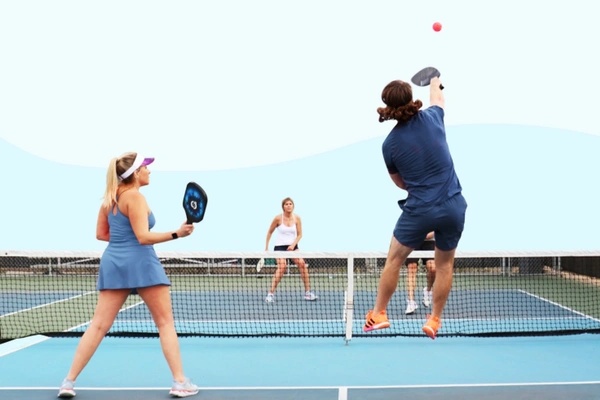
Pickleball lob shots have been a part of the pickleball game from the start, but in recent years, they’ve become more and more popular.
The lob is a powerful pickleball strategy to add to your arsenal. But it’s equally important to learn how to defend against it.
With a little know-how and practice, you can turn the pickleball lob shot from your Achilles' heel into your secret weapon.
A lob is a shot where the player hits the ball high into the air, sending it deep toward the back of the court.
When used offensively, the goal is to send it over the opponent’s head and force them back to the baseline. When used defensively, a lob shot can buy you time to get into a more strategic position and set up your own offensive shots.
Types of Lobs
Regular or Basic Lob
A regular lob isn’t complicated. It’s a shot hit on a high, curving trajectory, aimed to land near the opponent’s baseline. A regular lob requires a basic low-to-high paddle motion.
Top Spin Lob
A top spin lob is more aggressive and powerful than a regular lob. When the top spin is applied to the ball, it will shoot off more unpredictably when it hits the ground, making it extremely difficult to return.
Offensive Lobs and Defensive Lobs
What is an offensive lob in pickleball?
An offensive pickleball lob has a flatter trajectory than a defensive lob. It’s meant to curve just over the top of your opponent’s reach, landing in the court behind them.
An offensive lob is a great option when your opponent is at the edge of the Non-Volley Zone (NVZ) line (“The Kitchen”) since they’ll have to scramble backward to return the shot.
How do you hit an offensive lob?
Both technique and strategy go into executing a successful offensive lob. On the most basic level, you angle the paddle face slightly upward and follow through with an out-and-up motion.
You should be in a balanced position and able to get the paddle under the ball, lifting with your knees while lifting the ball upwards. Weight transfer should be in the direction of your intended target. The contact point will be in front of you, and fairly close. If you have to stretch to reach the ball you will have much less control.
Popular pickleball coach Simone Jardim points out some of the finer points of a perfect offensive lob technique:
Strategically, it’s important not to “telegraph” the pickleball lob shot. A lob shot works best when it’s a surprise. Beginner players will often change their stance when they’re preparing for a lob shot. Instead, keep your knees bent, body compressed, and paddle in front of you, the same as if you were preparing to hit a drop or a dink shot.
To apply spin, while striking the ball from below, you will use your wrist, elbow, and shoulder in one smooth motion to rotate the paddle in such a way that it “grips” the ball and rotates it. With some practice, this will feel natural in no time!
When is the Offensive Lob a Smart Shot?
The offensive lob works best when your opponent is near the Non-Volley Zone line, especially when they’re leaning in, anticipating a dink. Like a drop shot, it’s easier for you to successfully hit an offensive lob when you’re near the Non-Volley Zone.
The further back from the NVZ line you are, the harder it will be to successfully get the ball over your opponent’s head and out of their reach. The longer the ball is in the air, the more time your opponent has to react to your lob.
Finally, consider the elements. The sun in your opponent’s eyes will make the lob harder for them to see and successfully return.
The wind will make your lob either easier or harder, depending on its direction and strength. An offensive lob is easier to control when you’re hitting into the wind, rather than with it, but you have to be sure to hit it hard enough to clear your opponent's head. When the wind is at your back, it’s more likely to carry your lob out of bounds. Consider both when you are attempting a lob.
For more, check out master lobber Stephanie Lane’s best pickleball tips for executing a lob.
Where Should you Hit an Offensive Lob?
A good offensive lob is best hit over and behind your opponent and towards their non-paddle side. This will usually force your opponent to hit their next shot on the run with their backhand or run around the ball to attempt to hit it with their forehand. If your lob is short, they will have the opportunity to put themselves into a position to hit an overhead smash.
When Should Offensive Lobs be Avoided?
Awareness of your opponent’s location is key. Don’t lob the ball when they’re deep in the back of the court, for example. You won’t lob the shot over their head, and they’ll take the opportunity to smash the ball back at you.
Many pickleball players will attempt a lob as their third shot (instead of a third shot drop) after the double bounce rule has been satisfied. This is often not an effective shot because your opponents will be in prime position at the kitchen line and not be surprised by the lob attempt.
Tall players with long arms are harder to beat as a lobber. It becomes even more important to curve the ball higher to get it over them. Anything short will give them an easier time reaching it and likely result in an overhead smash.
Finally, avoid hitting an offensive lob when your body is in a poor position for it. You want the ball to be in front of you and fairly close when you make contact so you can easily get your paddle underneath it while keeping your body low.
What is a Defensive Lob in Pickleball?
Imagine your opponent is taking control of the point, and you’re scrambling to return the ball. In this situation, a high lob could be the safest and smartest way to stay in the rally. It’s a defensive shot and allows you time to reposition for the next volley.
With a defensive lob, the ball’s arc is higher, keeping it in the air longer. This also gives your opponent time to choose their best shot, which might be a fast overhead back at you.
How do you Hit a Defensive Lob?
Hitting a defensive lob is similar to hitting an offensive lob, but with two primary differences. One is the angle of your paddle at the point of contact, and the second is the direction of your follow-through.
For a defensive lob, your paddle’s open face should be pointing more toward the sky. At the same time, your follow-through should rise vertically, as opposed to out and away from your body with the offensive lob.
Just as with the offensive lob, try to avoid slapping the ball with a flick of the wrist. Get your body low and your pickleball paddle beneath the ball. Then guide and lift it upwards, putting your knees and weight into the shot. This gives you much better control.
When is the Defensive Lob a Smart Shot?
The defensive pickleball lob is used to buy time. When your opponents are at the NVZ line, keeping you back and on your heels, a defensive lob can help you be able to reposition yourselves and get back on the offense by forcing them to their own baseline.
Where Should you Hit a Defensive Lob?
As with the offensive lob, a successful defensive lob goes over your opponent’s head as far back in the court as possible, and preferably on their non-paddle side. This buys you more time, and it’s harder to return well.
When Should Defensive Lobs be Avoided?
The defensive lob is often a shot of last resort. It’s usually hit on the run, or from a vulnerable position and might be your only option to stay in the rally.
The same considerations apply to offensive shots. Try to avoid lobbing to a player who’s deep in the court and will be able to return it aggressively.
Beginners vs. Pro Player Lob Shots
Photo by Stephen Rahn on Flickr, marked as Public Domain (CC0 1.0)
Lobs are more effective against beginners. In fact, newer players often have a hard time hitting a return shot with them. Older players, also struggle with lobs due to limited mobility.
For advanced players, returning a lob is second nature. If executed poorly, you could set them up for the perfect overhead smash.
At the pro tournament level, professional pickleball players will be quick enough to get underneath a lob and return it successfully. So, disguising the lob and catching your opponent off-guard is key.
5 Tips to Hit Better Lob Shots
- Choose your opportunity carefully. A lob is most effective when your opponent is leaning in at the NVZ line, anticipating a continued dinking rally, or waiting on a high ball to put away.
- Put a top spin on the ball. Top spin dramatically increases the difficulty of returning your lob.
- Lob into the wind, not with it. Since a pickleball court is relatively small, when you lob the ball with the wind at your back, it’s harder to keep it in bounds.
- Disguise the lob. Lobs can be brutal when your opponent is caught off-guard, but they can backfire when they see it coming.
- Aim for the non-paddle side. Your opponent will usually have a harder time returning a lob hit to their non-paddle side of the court.
How to Defend Against a Pickleball Lob Shot: 5 Best Tips
For pickleball lob defense, you’ll need to either return the ball effectively or avoid the lob altogether. A few pickleball lob defense tips can help you turn lobs into golden opportunities to strike back at your opponent!
1. Anticipate the lob
Many players have “tells” that can clue you into what they’re about to do. Watch your opponent’s paddle angle and pay attention to their body language, and you may be able to anticipate a lob coming.
2. Target your opponent’s backhand side
If you think your opponent might be trying to set up an offensive lob, try hitting the ball toward the non-paddle side. Most players prefer to lob with a forehand shot, so your opponent might avoid it on a backhand.
3. Crush the lob back with an overhead
One good overhead smash just might make your opponent think twice about trying to lob the ball to you again. Your best opportunity to crush a lob will come when the lob is short, or if you can jump to reach it.
4. Chase the lob down
A lob only works against you if you can’t reach it. Don’t backpedal. Instead, drop the step by taking a small step backward and to the side, then run towards the baseline. Then, you can either get under the ball to return it or take a strong shot off of the bounce.
5. Keep your opponent near the baseline
Trying to hit offensive lobs from deep in the court is a losing strategy. Keeping your opponents in the backcourt will also take away their ability to hit an effective lob.
For more, check out PrimeTime Pickleball’s (100k+ subscribers) top strategies for defending a lob in pickleball:
Pickleball Lobs: The Bottom Line
In all levels of pickleball play, lobs are becoming more and more common, therefore being able to execute a successful lob is a key pickleball skill to master if you want to improve and be competitive.
Thankfully, learning to hit different types of lobs, as well as how to respond to them, isn’t too hard, as long as you understand the techniques and strategy behind them.
Now that you’re armed with the knowledge of how and when to hit a lob, and how to respond to one, with a little practice on the court, you’ll be a master of the lob in no time.
Tell us about your game. Do you use lobs? How often? Do you usually use them offensively or defensively? Do you find them easy to deal with when played by your opponent? Let us know on social!
